Peter Adam and Russell Smith
Will the US-Mexico Border WALL work? Well….it certainly may provide work, a lot of it — for those who build it.
This is intended to be a 2,000-mile-long structure, at least 18 plus feet high, to be made of reinforced concrete, with aesthetic embellishments and various and numerous support bells and whistles — access and patrol roads, fencing, drainage structures, motorized vehicle gates, light-emitting diode (LED) lighting, fiber-optic systems and communication towers. Its technology could also include remote video surveillance systems (RVSS), ground sensors, etc. It’ll have a hefty price tag up there in the multiple billions of dollars.
But, whether or not it will do what it’s meant to do, effectively — keep undesirable aliens out and restore greatness to American workers’ livelihoods — well…that certainly remains to be seen.
The Wall and Opinions from Both Sides of the (Political) Fence
The only certainties about this wall, so far, seem to be: it’s politically controversial, and the contentiousness surrounding it is likely to last as long as the wall stands, and perhaps longer.
OCI’s recent experience bears this out.
On March 23, we emailed out an analysis/summary of the WALL’s RFP to a few thousand of OCI’s business partners. Solicitation material had just been posted by DHS’s Bureau of Customs and Border Protection (CBP). Many of the email’s recipients responded. And they didn’t pull any punches. One called it: “the biggest boondoggle the Government ever created.” Another sent along a passage from Robert Frost’s famous poem, “Something there is that doesn’t love a wall.” Another said simply: “Good job.” And yet another opined, “I think the border wall goes against one of the great principles that we stand for. I urge you to avoid encouraging contractors to bid on it.”
Well, like it or not, press reports indicate that more than 600 companies have expressed interest in this project. That said — we join many of our colleagues in wondering: Will this wall be a success? Have others been? We suppose that depends on what one means by success. In any case, though, History provides us with some clues.
What’s Past is Prologue
This is hardly the first time a structure has been put up to secure a border. If and when this WALL is completed, it will rival other notably world class structures in size and scale. How it holds up against them in terms of design, impact, and effectiveness time alone will tell.
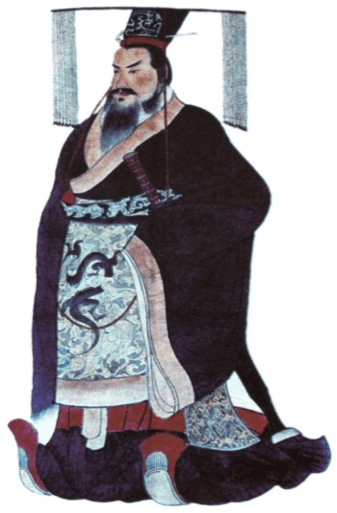
Qin Shi Huang — First Emperor of China and Builder of the Great Wall.
Past wall builders include the Imperial Romans (Emperors Hadrian and Antonine), the Qin Dynasty (Chinese Emperor Qin Lin Huang), the Vatican (Pope Paul IV), and, more recently, the USSR (Premier Khrushchev).
Their experiences, and the subsequent histories of the barriers they put up, indicate that such walls can be quite costly, in monetary, human toll and political terms. And their structures’ overall effectiveness? Well, that’s proven to be questionable, at best…
The Great Wall of China
This was the Handiwork of Qin Shi Huang (Chinese 秦始皇) – (259 – 210 BC) founder of the Qin Dynasty and the first Emperor of a unified China. Ultimately, his 5,500-mile structure was, at best, only partially successful. It finally failed to keep out well armed troublemakers from the North. After streaming through the Great Wall’s gates at Shanhai Pass, the Manchus sacked Beijing in 1644, effectively ending the Ming Dynasty, whose rulers had been depending on their First Emperor’s wall to preserve.
Until it recently became a popular tourist destination, Emperor Qin Shi Huang’s structure was not looked upon favorably. Financed by silver which had to be shipped all the way across the Pacific from Peru, it was E X P E N S I V E — expensive. And not just in monetary terms. Built by conscripted labor, its human toll was as monumental as the structure itself and its cost.
Emperor Qin Shi Huang wasn’t antiquity’s only wall builder. Hadrian (76-138 CE), the Fourteenth Emperor of Rome, was also.
Hadrian’s Wall
Ascending to the throne in 117 AD, Hadrian suffered constant harassment from various conquered peoples, including the Caledonian tribes that dwelt in what’s now Scotland.
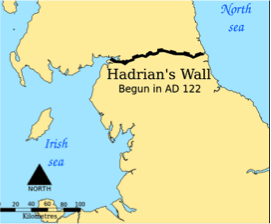
Hadrian’s Wall — Part of a fortification structure that ran along the northern border of the Roman Empire.
So what to do? Well, on the northern frontier of Britain, he built a wall — Hadrian’s Wall (Latin: Vallum Hadriani). And he did it quickly. From AD 122 to 28, Hadrian’s legions put a stone and sod structure in place that stretched across the entire UK, east to west.
Hadrian’s Wall was far more modest in size and length than either Emperor Qin Shi Hang’s Great Wall or what’s now planned for the Mexican – US border. The stone component was only 80 Roman miles long (vs. the GW’s 5,500 miles and the US-Mexican wall’s 2,000).
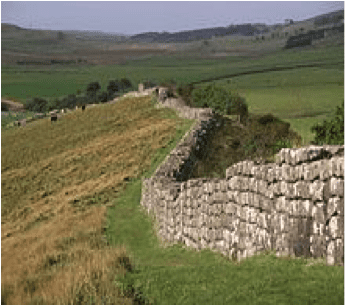
Still Standing — Parts of Hadrian’s Wall are still partially intact; over the centuries, Brits have “borrowed” stones from it for homes, barns, other walls, and whatnot.
Made principally from squared stone, Hadrian’s Wall was roughly 10 feet wide and varied from 11 to 20 feet in height.
With troops garrisoned along it every five miles or so, Hadrian’s Wall apparently kept cattle rustlers and trouble makers at bay, and helped prevent tribes of Caledonians from migrating southward, for a while, at least.
Given the structure’s design, its cost must have been a mere fraction of the Great Wall’s, totally, and on a per cubic foot basis. And it’s difficult to see how the human toll in its construction could have been anywhere near what Emperor Qin Shi Huang’s Great Wall was.
In any case, Hadrian’s Wall is the largest standing Roman artifact, anywhere. Like the Great Wall, it’s become a cultural icon, and a major tourist attraction.

Hail Hadrian! – One of antiquity’s wall building greats, he was known as a Just Emperor.
Unlike Emperor Qin Shi Huang though, history seems to consider Hadrian’s Wall’s builder exemplary; he’s one of the so-called “Five Good Emperors” who ruled the Roman Empire justly.
The fact that the Romans were able to hold onto the occupation of the island another two hundred or so years, and that it took the Mongols more than a millennium to finally defeat the Ming Dynasty would suggest that these walls were, at least to a certain extent, militarily effective.
The Leonine Wall
In response to a Saracen (Arab/Moslem) raid on the Vatican and the looting of the Basilicas of St. Peter and St. Paul which took place in 846 AD, Pope Leo IV had another wall constructed – so as to preclude any further similar incidents. 110 acres.
Completed in 852, the 40 foot high, 12 foot thick structure, defended by dozens of towers, turned the Vatican into a fortified city.
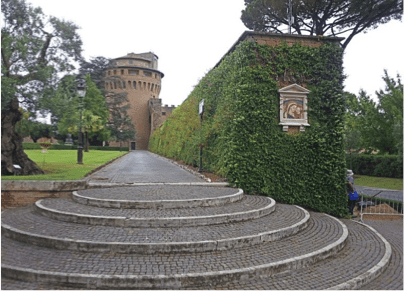
The Leonine Wall – Pope Leo IV’s handiwork has proven effective in keeping Saracen raiders out of Vatican City for over two millennia now.
Known as the Lenonine Wall in honor of its founder, this barrier has stood the test of time better than its aforementioned barrier wall counterparts in ancient China and what’s now the UK.
Of course protecting the Vatican City, which is only 110 acres in size, is a far cry from protecting the northern reaches of Emperor Qin Shi Huang’s empire, or the Roman Empire in its heyday. Still, the Roman Catholic Church has successfully outlasted the Ming Dynasty and the Roman Empire, and the Vatican has not been looted since Pope Leo IV had it encircled with a wall.
The Berlin Wall – Barriers Ain’t What They Used to Be
In 1961, to stem the flow of people crossing over from the communist sector of the divided city of Berlin to the West, non-communist, free and democratic side, Premier Khrushchev of the Soviet Union, and his counterparts in East Germany and East Berlin, had a wall built across the city, which quickly became flashpoint for tension between the United States (and the rest of the free world) and the Soviet Union.
Before the rise of the Berlin Wall in 1961, 3.5 million East Germans circumvented Eastern Bloc emigration restrictions, many by crossing over the border from East Berlin into West Berlin, from where they could then travel to West Germany and other Western European countries. Between 1961 and 1989, the Wall prevented almost all such emigration.
The Berlin Wall’s structure was formidable. Originally, it was more than 140 km (87 mi) long. In June 1962, a second, parallel fence was built some 100 m (110 yd) farther into East German territory. The houses contained between the fences were razed and the inhabitants relocated, thus establishing what later became known as the death strip. The death strip was covered with raked sand or gravel, rendering footprints easy to notice, easing the detection of trespassers and also enabling officers to see which guards had neglected their task; it offered no cover; and, most importantly, it offered clear fields of fire for the Wall guards.
Through the years, the Berlin Wall evolved through four versions:
• Wire fence and concrete block wall (1961)
• Improved wire fence (1962–1965)
• Improved concrete wall (1965–1975)
• Grenzmauer 75 (Border Wall 75) (1975–1989)
The wall slowed down, but did not stop a “brain drain”. Those willing to try to escape from East to West, were typically risking death or at least imprisonment and other punishments. And there were more than a few.
Some, particularly those who were daring and imaginative, were successful, right off the bat. One escapee obtained an East German military uniform and just casually walked over from East to West. A group of about a dozen elderly folks tunneled across – successfully; their escape route became known as the “senior citizens tunnel”. Others drifted across in balloons, walked over it on tightropes or zipped their way to freedom using zip lines.
Not everyone made it safely to the other side, of course. There were many deaths at the Berlin Wall, over its lifespan which lasted from 13 August 1961 until 9 November 1989.
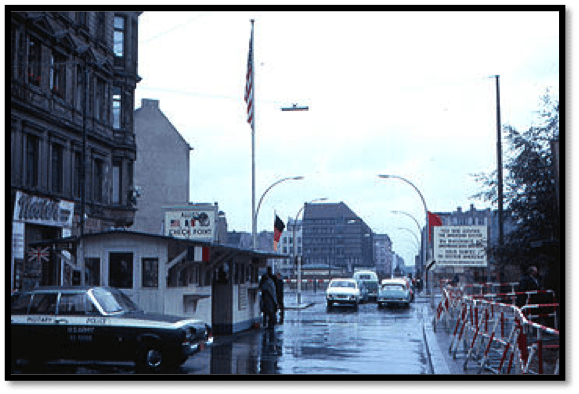
Check Point Charlie – The View from the American Sector of Berlin in 1963.
The state-funded Centre for Contemporary History (ZZF) in Potsdam has pegged the number, officially at 139, including attempting escapees, border guards, and innocent parties. However, researchers at the Checkpoint Charlie Museum and some others have estimated the death toll to be significantly higher. (Checkpoint Charlie (or “Checkpoint C”) was the name given by the Western Allies to the best-known Berlin Wall crossing point between East Berlin and West Berlin during the Cold War.)
The escape attempts claimed the lives of a wide variety of people, from a child as young as one to an 80-year-old woman, and many died because of the accidental or illegal actions of the guards. In numerous legal cases throughout the 1990s, several border guards, along with political officials responsible for the defense policies, were found guilty of manslaughter and served probation or were jailed for their role in the Berlin Wall deaths.
In comparison with the walls built by the ancients, the Berlin Wall was short lived — lasting less than three decades. And it wasn’t brought down by military force.
In the later 1980s, as some of E. Germany’s East European neighbors loosened travel restrictions, the flood of departures from East Germany to the west swelled, uncontrollably. And the authorities in East Europe were unable to stem this.

Free at Last — Gravestones of some of those who died at the Berlin Wall.
Finally, the East German authorities ordered the border guards at the Berlin Wall’s crossing points, to, in effect, stand down and allow anyone to cross from East to West Berlin, and mobs of people, had at it…. And the wall came a tumblin’ down!
The final fall of the Berlin Wall (German: Mauerfall) began the evening of 9 November 1989 and continued over the following days and weeks, with people nicknamed Mauerspechte (wall woodpeckers) using various tools to chip off souvenirs, demolishing lengthy parts in the process, and creating several unofficial border crossings.
The US Mexico Border Wall’s Bottom Line

Ich Bin Ein Berliner – In 1961, President Kennedy stood near the wall and promised to defend W. Berlin.
The commitment to building a barrier represents a turnabout in US policy; previously Americans have supported tearing down walls, not putting them up.
And it remains to be seen whether this structure works as intended or not. Still a Wall, or something along the lines of a beefed up no-go zone along the US-Mexico border is likely to be established.
In any case, as things now stand, Phase I and (those fortunate enough to be) Phase II bidders are unlikely to use the same workforce motivation techniques that went into the Great Wall and Hadrian ’s Wall. After all, the present administration owes its victory at the polls, at least in part, to promises to help workers fare better overall. And the wall and its pay scales are likely to reflect this. Still, price is part of the evaluation and winning decision mix. This will be a Best Value, Trade Off deal. And labor costs will be a big part of the price and mix. It may not be make or break here, but value, which always comes down, at least in part to dollars and cents, will be important.
It will be interesting to see how this plays out, as well as whether this structure works as intended, or disappoints.
Funding is another issue. The Wall is a big ticket item. And if Congress does not pass go for the for the entire structure — and deficit hawks are likely to balk at the price tag – then a scaled-back fence-like solution may be substituted for the reinforced concrete structures, as specified in the initial RFPs. If this happens, it will increase the importance of sensors, detection devices and other related security measures, devices, etc. Bidders are encouraged to be flexible, and focus not only on design, but alternatives to concrete and steel structures and detail their logistics, work force stand up and deployment and supply capabilities and experience.
Designing a wall or other border securing structure is one thing. Implementing the massive effort needed to put it in place, without using antediluvian work practices of the ancients to erect their timeless and monumental structures, is quite another.
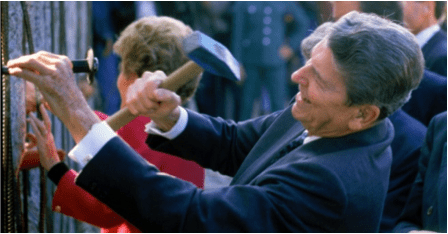
“Tear Down this Wall!” – In 1987, President Reagan implored the Soviets to tear down the Berlin Wall.
Proposals that highlight the contractor’s flexibility and the ability to scale up as well as down and respond quickly and efficiently to evolving requirements are far more likely to make it to the second Phase II round and help construct the monumental structures that are going to be built along the US- Mexican border.
In any case, regardless of how this plays out, the Wall’s unlikely to have much of an impact, longer term, on the changing nature of American society. Hispanic people are a significant and growing component of the US cultural and ethnic mix. Hispanic and Latino Americans have been accounting for roughly 48% of the national population growth of about 3 million annually. Immigrants and their U.S.-born descendants are expected to provide most of the U.S. population gains in the decades ahead.
So…Amigos — Bienvenidos a los Nuevos Estados Unidos! Y vamos a ver cuánto dura este muro…(We’ll see how long this wall lasts).





Leave A Comment